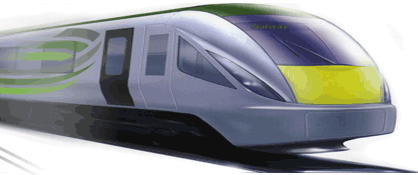West=On=Track
-News
Let's put the west back on
track
Irish Times June 12th
2006
We need a well integrated and connected transport network
to counter the concentrated economic activity on the east
coast, writes Lisa McAllister.
Last Wednesday's Irish Times article by Frank McDonald
argued: "The Government ignored doubts over the Western Rail
Corridor" and implied there was no case for its
reinstatement or that its potential viability had not been
properly scrutinised.
This is simply not true - in fact, the opposite is the
case. Nor is it the case that money earmarked for the
corridor should be spent on the roads. Quite simply it is
not either/or - the western region badly needs both.
Putting the region in context, there is a population of
742,877 in the seven counties served by the Western Rail
Corridor (Census 2002) mostly in the immediate catchment
area.
Add to this the Central Statistics Office's population
projections which indicate that the west will be the second
fastest-growing region, increasing its population by 35 per
cent by 2021. The border population is expected to rise by
26 per cent and that of the midwest is expected to rise by
20 per cent by 2021. If these people are not catered for,
they could always add to the gridlock in Dublin.
The Government set up an expert group that was
independently chaired by former chief executive of Jurys
Hotel Group Pat McCann.
Its task was to examine the case for reopening the
Western Rail Corridor and this group recommended its
immediate reopening on a phased basis.
As part of this group, the Western Development Commission
agrees that investment in the corridor makes economic sense.
Unlike many major capital investment programmes, the basic
infrastructure for the Western Rail Corridor is already in
place - the land is in public ownership and there are no
planning issues.
Iarnród Éireann was a full member of the
expert group that asked internationally respected
consultants FaberMaunsell to study the capital cost
estimates and the potential demand for the line.
FaberMaunsell put the capital costs of restoring the line
from Sligo to Ennis at euro365.7 million, or just 1 per cent
of the total budget of the transport investment programme -
Transport 21.
Phase one - from Ennis to Claremorris - would cost
euro168.3 million, less than half of 1 per cent of Transport
21's total budget.
Public transport spending in the Border, Midland, West
(BMW) Region under the National Development Plan was just
over half of that forecast for 2000-2005.
This compares with a 7 per cent overspend in the South
and East region. Phase one of the Western Rail Corridor
could be completed for a fraction of the euro2.5
billion-plus underspend in the BMW region at the end of 2005
and it could be completed in 18 months unlike many other
measures proposed under Transport 21.
Services on the corridor will link existing rail lines
emanating from Dublin, improving rail connections and
integrating the rail network more comprehensively.
We believe this will generate additional demand with many
new commuting services possible.
Also the Western Rail Corridor would provide much needed
improved connections to Knock airport, the only
international airport in the BMW region. This airport is
growing rapidly with passenger numbers rising 42 per cent in
2004-2005. The rail corridor will also provide improved
access to Shannon International Airport.
As well as having thousands of small and medium
enterprises, the region also has major clusters of big
international businesses ranging from medical devices to
IT.
To compete globally these firms need a serious upgrade of
the region's transport infrastructure as the movement of
people and knowledge is essential to them.
Also, tourism, an important element in the region's
economy - where the trend is to shorter more frequent
holidays, needs much better transport access to and within
the region.
There are two million bus passengers and over seven
million cars travelling the Sligo-Limerick route annually.
The N17 route at Claregalway is one of State's busiest.
Providing a rail service will in itself generate demand.
This has been the experience with the opening of the
Limerick-Ennis line. Passenger numbers in the first year of
operation exceeded all expectations.
Currently there are no plans for the reintroduction of
services as far as Sligo, which is experiencing exceptional
growth, and will be the only gateway town whose rail link to
other gateways is via Dublin.
This strategic rail line, when reopened, will link
Limerick, Galway, and Sligo, with onward connections to Cork
and Waterford. It will also link these cities to Ennis,
Tuam, Castlebar and Ballina via a public transport network
as advocated in the National Spatial Strategy.
Furthermore, in linking Sligo to Limerick, 14 smaller and
medium towns along the route will reap direct and almost
instantaneous benefits. The reopening of the Western Rail
Corridor is stated Government policy.
A well integrated and connected transport network is what
the country needs to grow in a more sustainable regionally
balanced manner, providing a counter attraction to the
concentration of economic activity on the east coast.
Improved accessibility will help the region to capitalise
on the advantages of living and working in the west - as
does the the message of the Western Development Commission's
Look West campaign that encourages people to move there.
Lisa McAllister is chief executive of the Western
Development Commission.
© The Irish Times 12/06/06
|
